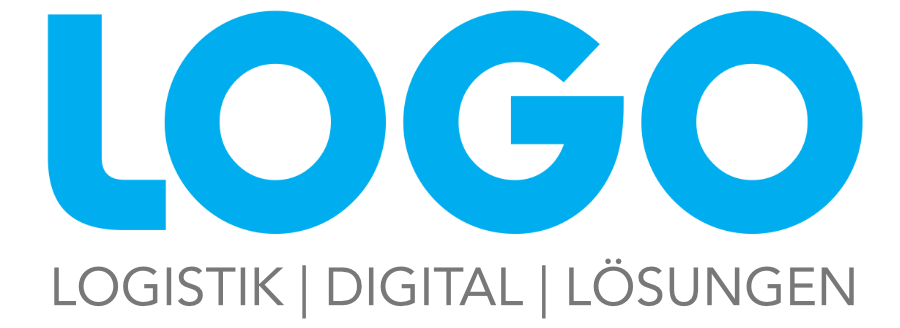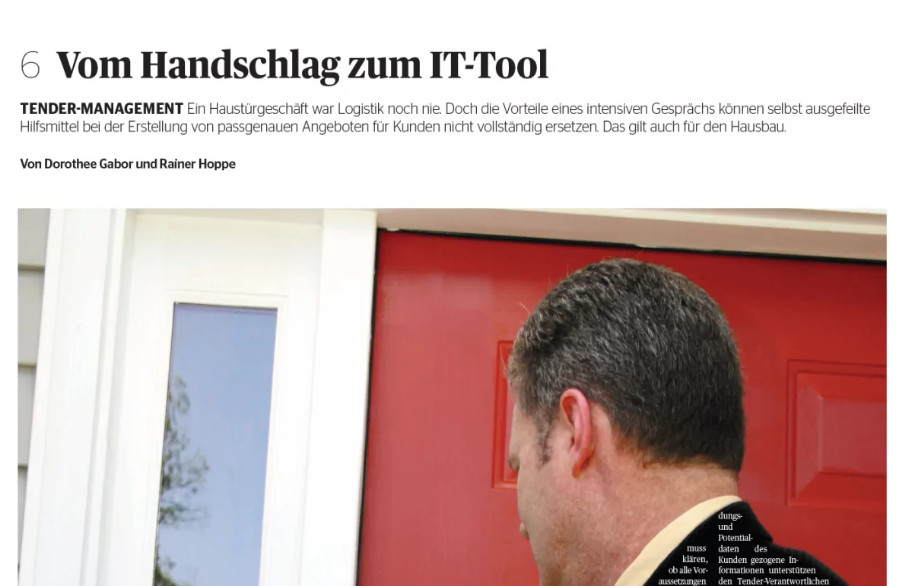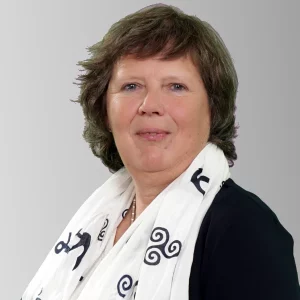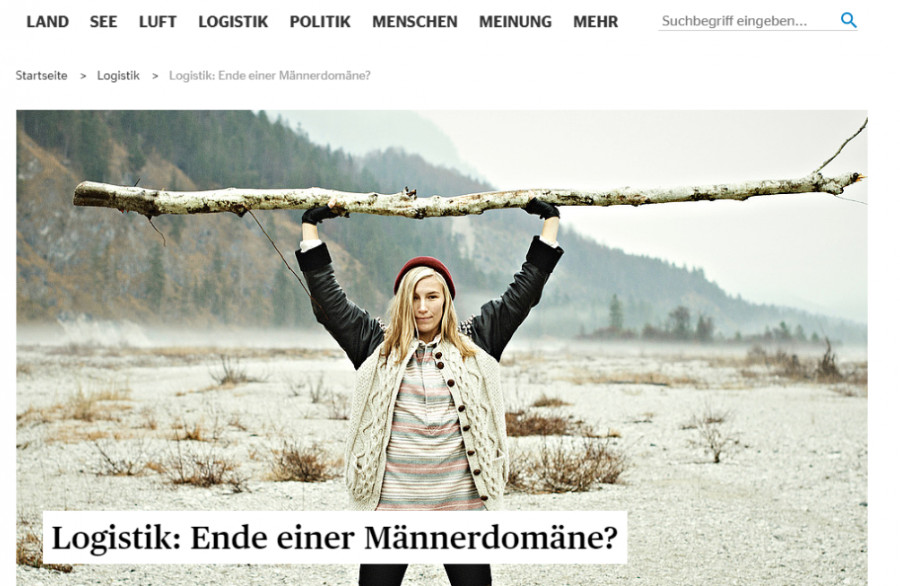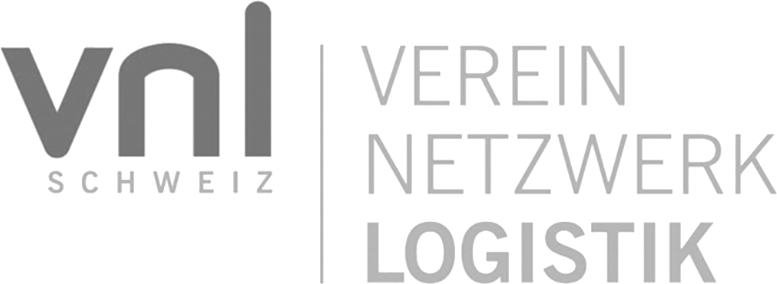In this year’s XXL theme issue, DVZ highlights numerous processes in logistics and compares them to processes in house construction. LOGO consult was asked to contribute on the topic of tender management. Part of it was published in the XXL-Theme booklet printed. You can find the full text of the article here.
The tender construction site: Successfully expanding business with planning, control and communication
A medium-sized logistics company wants to expand. The owners have long considered whether the investment is the right step to keep the company competitive and lead it into the future. A new branch of the company is being established. A new high-bay warehouse is to be added to the existing warehouses, office buildings, depot and workshops. State of the art with automated forklifts, fully automatically controlled, a big investment in the future.
Let’s call the company TopLogistik.
The management of TopLogistik has a plot of land in mind, an architect is to do the planning, a construction company is to implement the project, an intralogistics service provider will equip the warehouse. Everyone has to work together from the very beginning. Nothing must be overlooked in the planning phase. The budget must be adhered to, a schedule is drawn up.
Finally it starts: the ground-breaking ceremony. The management team stands solemnly on the building site and now everything has to work out.
We can imagine what is going on at TopLogistik until the warehouse is finished and all processes are running.
An ideal balance between quality and price is sought. The trades are assigned and the site manager makes sure that the various subcontractors are ideally timed. A foreman supervises the construction work and controls all the tradesmen.
If unexpected delays occur, the alarm must be sounded in good time. If the building ground is not as stable as expected, the risks must be weighed up quickly and the plans possibly changed.
Without good communication between all parties involved and transparency about risks, status and schedule, it cannot work.
It is similar when a logistics company participates in a tender.
A tender becomes known. Whether it comes via a platform or whether the customer publishes it himself makes a big difference. Whether the tender comes from an existing customer or whether there is no business relationship yet determines the procedure.
Sometimes the tender belongs to a customer that does not yet do any business with the department currently concerned, but is a very important customer of another department. For example, it is a tender for land transport and the customer has so far only been represented with air freight.
An employee who has been informed about the tender enters the key data. Depending on the division to which the tender applies, the basic data is passed on to a decision-maker. The decision-maker has the task of clarifying whether the company should participate in the tender or not. Many factors are important for this, and if possible they were already researched and communicated in the first step.
This is very similar to TopLogistik, when the management team has to make the decision whether the new fully automated warehouse should be built:
- Does the time frame fit?
- Are there sufficient capacities available?
- Are equipment and safety requirements OK?
- Do the technical requirements fit?
- How high is the prospect of success?
- Who are the competitors and what are their advantages and disadvantages?
- What would be the turnover and profit?
- Is there a chance of winning the tender with cost-covering prices?
Once the tender manager has decided that the company should participate in the tender, internal communication is started.
The tender is divided into subtenders that have to handle different company divisions, employees or agents. Each subtender has a deadline to ensure that the overall tender can be submitted on time. The insurance and finance experts have to give their assessment. IT has to clarify whether all requirements would be met.
Subtenders can be thought of like the trades on a building site. If the gears don’t mesh properly, problems will arise. If the prefabricated parts of the walls and ceilings are delivered before the floor slab is ready, they cannot be installed right away. If the electrical installation is not ready, the conveyor belts cannot be connected.
In the same way, the overall tender cannot be submitted if a national company does not submit its figures on time.
Just as the site manager receives information from the foreman when the schedule cannot be met, the person responsible for the tender must receive the information in good time when there is a snag or a bottleneck somewhere.
This is where a good tender management tool can help. With striking visualisation and proactive alarms as well as escalation levels, the tender manager can quickly see whether everything is in the green or whether he needs to intervene. Those involved in the tender have joint access to the planning and can also always see the current status, the deadlines and the chances of success entered by the tender manager.
If a site manager does not have a reliable foreman, he is at a loss. The situation is similar for many tender managers who, due to a lack of communication and transparency, often do not realise until it is too late that they no longer have a chance of winning the tender. Unlike on the construction site, however, technology can help here.
Good process management, workflows tailored to the company, visualisations and proactive alarms can prevent such problems.
I am the site manager who is supposed to coordinate everything. I am a representative of LOGO consult, manufacturer of the standard logistics CRM solution LOGO CRM. With our tender management tool, we are supposed to provide technological support for tender processing.
I am interviewing a “client” for whom I have taken on the task of organising and monitoring the planning and implementation of a tender well.
His day-to-day business is organising logistics tenders: Marc Pinheiro, Managing Director, M&M air sea cargo GmbH
- LOGO: “Mr Pinheiro, What are the biggest challenges in successfully handling logistics tenders?”
- Understanding what the customer really wants. Most of the time, it was communicated that they want the “egg-laying-willing-milk sow”, but in reality they just want to pay for a “chicken”. To consider the needs and wishes of the customer outside of the “cold matter of costs” is the real challenge.
- LOGO: “What factors have caused you to be dissatisfied with the outcome of a tender in the past?”
- Lack of information to successfully evaluate a tender before processing. Through evaluation and analysis, one can weigh the costs/benefits of processing a tender and thus achieve a higher chance of winning.
- LOGO: “Why has the handling of tenders in logistics long since become a strategic management task to align companies profitably?”
- Strategically and product trained employees (specialists) are needed to win tenders more successfully and profitably. In the logistics environment, competition has become tougher due to the mass of providers and the stringent cost-cutting pressure from customers. Decisions about profitability have now become management tasks … even non-profitability to secure business is a management task.
- LOGO: “At what point can technology help you become better?”
- Digitisation. Storing data neatly, easily and accurately, then analysing it and deriving the service solution in a customer-oriented way.
- LOGO: “What is the direction of tendering in logistics in the coming years?”
- Unfortunately in the wrong one! Digitalisation is not always positive. Tenders run via e-platforms. Are price- and not solution-oriented. Tenders thus lose the human “touch” and no customer relationship can be built through electronic transmission of responses to a tender.
- LOGO: “What becomes important besides price?”
- Quality, integrity (of the data)! However, in most cases at a clearly defined price level.
- LOGO: “How to process tenders faster and more profitably than before?”
- Good and qualified processing of a tender usually starts when a tender has been won or lost. Preparation for the next tender! Time is less of a factor than quality, finding solutions, putting together the package that clearly defines the logistics provider as the winner, along with the “right” price.
The work of tendering cannot be made more profitable. On the contrary. Specialists/time/labour cost money. But it is worth it.
- Good and qualified processing of a tender usually starts when a tender has been won or lost. Preparation for the next tender! Time is less of a factor than quality, finding solutions, putting together the package that clearly defines the logistics provider as the winner, along with the “right” price.
- LOGO: “And what about the “trust” factor, which still often plays a role in construction – as well as (previously) in logistics? A handshake and a deal is sealed. Does that still exist? Trust and experience are difficult to grasp and then evaluate in tenders.”
- Trust plays a role with the slightly older generation in purchasing. Here the buzzword is integrity again. Today’s so-called purchasing specialists, however, hardly look beyond the edge of the screen. Price and cost savings are in the foreground. Quality requirements are defined in specifications, which are then evaluated by malus/bonus. E-bidding à la Ebay on so-called platforms is usually in the foreground. It is almost impossible to build up a basis of trust.
So building owners, construction managers and craftsmen do not have it easy when it comes to expanding business via tenders.
Digitalisation is both a blessing and a curse. A blessing in terms of internal processes, but more of a curse when it comes to award decisions due to the lack of individuality.
As Mr Pinheiro says, the true customer wish also plays an important role in tenders. Those who have really taken up the CRM idea are on the lookout in all sales activities for what the customer needs, what drives him, what concerns he has and with what services or knowledge their own company could make the decisive difference for the customer.
A clear, non-cluttered and easy-to-understand presentation and processing of tender data in the CRM helps everyone involved to work effectively and in a structured manner.
Good documentation of previous tenders and previous discussions with the client can help in assessing a tender.
Information automatically drawn from the customer’s consignment and potential data supports the tender manager in deciding whether to participate.
Good structuring of tender data helps to maintain an overview.
Traffic lights that are automatically switched to red, yellow or green based on rules have a signalling character and support the tender team.
Workflows and background calculations prevent mistakes from being made due to unknown data.
A good rights concept ensures that all participants can see exactly the information they need for their part of the tender.
Improved internal communication and better transparency greatly reduce the flood of e-mails about tenders and save a lot of time.
With good planning, control and communication, tenders can be successfully processed and the tender construction site runs “like clockwork”.
……………………………………………………………………………………………………………………………………………………………
+++ Start INFOBOX +++ Tender Management +++
Tender management: organisational and calculative task
Tender management is a logistical challenge for almost every service provider, because many participants have to work together precisely in a short period of time while calculating exactly.
These five tips will help you to submit a successful bid:
- Prequalify decisively
Tender costing requires a great deal of attention and involves many people. But one service provider cannot reasonably handle every tender. Assess your resources, pre-qualify the tender and make a binding decision: To bid or not to bid? Less is more. Only what you can really cover should be offered. - Organise tightly
You can only win a tender if you use your resources optimally: Calculate costs and prices quickly, merge data, prepare a transparent competitive offer and submit all documents on time. In short, the process has to be right and everyone involved has to work closely together. This is often an athletic challenge, especially in international tenders with a wide variety of internal and external participants. The more structured you work, the more convincing the result will be. IT support helps to systematise the process and creates transparency at the same time. - Calculate precisely
Tendering is only fun when the results are right in your day-to-day business and you also earn money with your customers. To ensure this, you need to have your data under control from the outset and be able to calculate quickly, but above all accurately. For this to succeed, all service providers must submit their conditions quickly and on time. At the same time, you should be able to calculate simulations that show you your margin depending on the tariff. For both tasks, there are tools that improve your performance. - Offer transparently
Your offer is convincing if your customer can understand the price and your unique selling proposition becomes clear. Calculate with open books – then there will be no discussion about your costs. Because transparency wins. And on this basis you also best convey your individual strengths and create trust. - Stay consistent.
Once you have decided to offer a tender, the key is to follow through! The more people involved, the more complex the process – but even one failure will take away your success. And the first shot has to be right! Prevent tactics. All players in your organisation must pull together. Process-supporting tools not only improve tender management, they also create transparency. Those who do not participate will then stand out.
Quelle: A’PARI Consulting GmbH
+++ End of INFOBOX +++ Tender Management +++
Author: Dorothee Gabor, Board of Directors Business Development at LOGO consult AG. www.logo-consult.com
Co-Authors:
Marc Pinheiro, Managing Director M&M air sea cargo GmbH
Rainer Hoppe, Managing Partner, A’PARI Consulting GmbH
